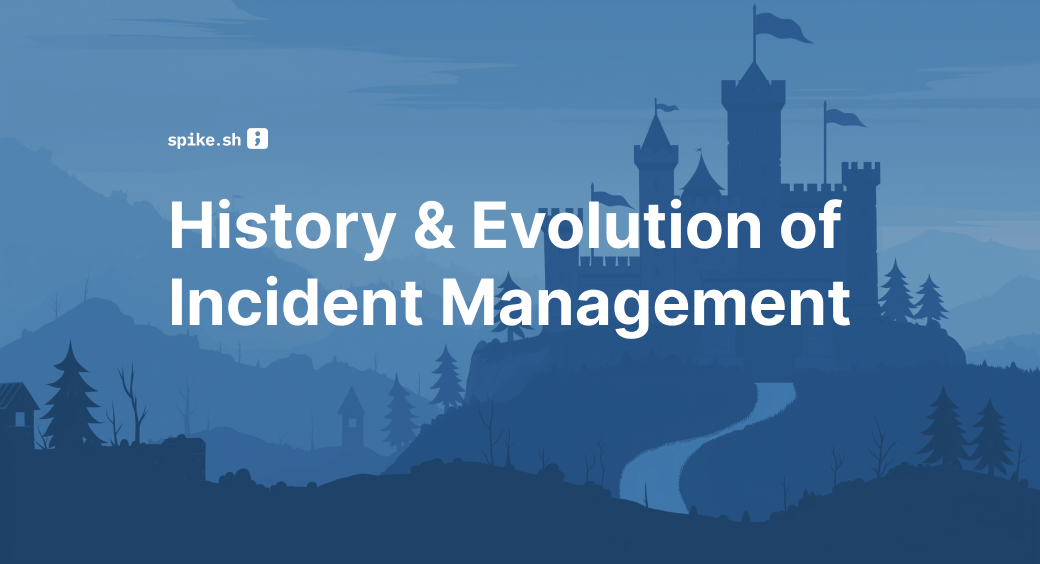Throughout history, incidents—unexpected events requiring a planned response—have been a constant.
From ancient empires to today’s digital landscapes, the way we manage incidents has evolved significantly, reflecting societal changes and technological advancements.
This post delves into the fascinating journey of incident management, from its rudimentary beginnings to the sophisticated systems in place today.
Early Days of Incident Management
The roots of incident management can be traced back to ancient civilizations, where the earliest forms of incident detection and response were practiced.
A quintessential example is the use of watchtowers in small kingdoms. These towers were strategically positioned to oversee vast areas, serving as the first line of defense and incident detection.
Soldiers stationed in these towers had the critical task of monitoring for any signs of trouble, be it approaching enemy forces, natural disasters like wildfires, or other significant events.
Upon detecting an incident, soldiers used various methods to relay the information back to the kingdom.
These included:
Fire Signals: By lighting fires or using torches, soldiers could create visible signals that conveyed urgency and the type of incident.
Sound Signals: The use of sound, such as bells, horns, or drums, was another method to alert the kingdom.
Flag Signals: Flags or banners were used during the day when fire and sound signals were less effective.
Human Messengers: For further incident relay, human messengers were dispatched. They would carry specific details about the incident, such as its nature, location, and potential impact.
What happened after message is received?
Once the alert was raised, the kingdom would mobilize its response immediately.
This typically involved:
Rallying the Troops: Soldiers and guards would be assembled, armed, and briefed on the situation.
Strategic Planning: Commanders would quickly devise a strategy based on the nature of the incident, whether it was a military threat, a natural disaster, or other emergency.
Public Warning: For incidents like natural disasters, the public would be warned and instructed on safety measures.
Resource Allocation: Necessary resources, such as water for fires or reinforcements for an attack, were mobilized and dispatched.
These ancient strategies, though rudimentary compared to today’s standards, laid the foundation for modern incident management principles.
The emphasis on early detection, rapid communication, clear role delineation, and prompt response are as relevant today as they were in the times of watchtowers.
Game Changers in Incident Management
The shift from early methods to structured incident management approaches began as societies became more complex.
The introduction of organized emergency services and formalized response plans marked a significant evolution.
However, it was the development of systems like the Incident Command System (ICS) and the National Incident Management System (NIMS) that truly transformed incident management.
Incident Command System (ICS)
The Incident Command System (ICS) emerged in the 1970s in response to a series of catastrophic wildfires in California.
It was designed to offer a standardized approach to incident response, regardless of the incident's size or complexity.
ICS’s key features include a clear chain of command, flexible organizational structures, and prioritization of responder safety.
National Incident Management System (NIMS)
Parallel to ICS, the National Incident Management System (NIMS) was developed post-9/11 as a comprehensive approach to managing incidents.
NIMS provides a consistent nationwide template to enable all government, private-sector, and non-governmental organizations to work together during domestic incidents.
Its adoption marked a significant step in unifying incident response across different sectors and jurisdictions.
The principles of ICS and NIMS have significantly influenced software incident management. The same concepts of coordinated response, clear communication, and structured procedures are now adapted to manage digital crises.
Incident Management in the Digital World
The evolution of software incident management has mirrored the rapid development of information technology.
In its infancy, software incident management was a reactive, ad-hoc process, often lacking clear protocols. Today, it has morphed into a sophisticated discipline featuring automated tools, real-time monitoring, and predictive analytics.
Technological advancements have significantly shaped this evolution. Automation has accelerated response times, while AI and machine learning offer predictive insights to pre-emptively tackle incidents. Cloud computing has brought scalability, allowing incident management systems to expand or contract resources as needed.
The current best practices in software incident management emphasize not only technological prowess but also a strong focus on human elements such as team coordination, training, and stress management.
These practices highlight that at its core, effective incident management is about orchestrating human and technological resources to resolve crises efficiently.
Modern Incident Management in Action: A Case Study from Spike.sh
Let's take a closer look at modern incident management through a real-life example.
Recently, we at Spike.sh faced a critical incident: an SMS alerts outage. Given our global operation spanning over 100 countries, this was a challenging situation considering the intricacies of SMS services across various regions, countries, and carriers.
The issue came to light when a significant volume of errors were detected within a very short window, thanks to our alert system that monitors incident frequency.
Initially marked as severity 2, our on-call responder quickly escalated it to SEV1 (critical) upon reviewing the repeat and suppress rates.
We immediately created a war room using Spike.sh and mobilized the team within minutes through automated phone calls.
Our team's response was swift and coordinated. We created an action plan, divided duties, and kept our customers informed through automated updates on the status page, a feature activated when an incident is escalated to critical status.
This efficient communication and rapid response strategy allowed us to identify anomalies and patterns in the errors, resolving the downtime in just 12 minutes—a situation that could have lasted much longer without our advanced alert system.
At Spike.sh, we don't just manage our incidents; we empower you to manage yours with the same level of efficacy and efficiency.
Whether it's an unexpected outage or any other critical incident, our platform is designed to offer rapid detection, clear communication, and efficient resolution.
Interested in learning how Spike.sh can transform your incident management process?
Signup for a demo: https://spike.sh/demo
Conclusion
The journey of incident management from ancient watchtowers to digital dashboards reflects a fascinating intersection of history, technology, and human ingenuity.
Understanding this evolution is not just a retrospective exercise; it offers vital insights into how we can better prepare for and respond to the unexpected.
As we move forward, emerging technologies like AI and machine learning are set to enhance predictive capabilities, automate responses further, and foster more resilient systems.
This blend of past wisdom and future innovation promises a more effective approach to managing incidents.

